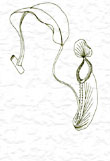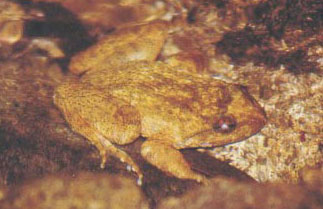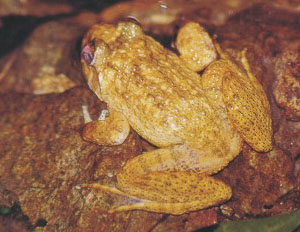

 |
 |
Wild Corner
Any sightings of civets, mongooses, ferret badgers, leopard cats, barking deer, pangolins and porcupines Ö live or dead Ö should be reported. Rare birds, reptiles, amphibians and fish, or unusual behaviour by common species, are also of interest, as are rare or interesting invertebrates and plants. If you think it is interesting, our readers probably will! Please give dates, times and localities as accurately as possible.
MAMMALS
James Varley saw a Porcupine (Hystrix brachyura) on Black's Link near Wong Nai Chung Gap at around 7:45 pm on 6th December 2000.
A single sub-adult male Rhesus Macaque (Macaca mulatta) was spotted by Richard Corlett on the Tai Mo Shan Road at about 650 m on 14th April. It looked in very poor condition.
Valery Garrett saw a Masked Palm Civet (Paguma larvata) behind her house on Mount Kellett Road at 8:30 pm on June 27th 2000, and regularly hears Barking Deer in the same area.
On 28th May, Richard Corlett and Jan Littlewood saw an elderly couple systematically feeding a rice mixture to a group of seven Feral Dogs in Kam Shan Country Park, about 2 km from the main road. It is now illegal to feed wild animals in this area, but feral dogs possibly do not count as wild. If this practice is widespread, it may account for the presence of apparently healthy groups of feral dogs in many of the more accessible Country Parks. The ecological impact of these dogs is unknown but they are a potential threat to walkers and a possible reservoir for wildlife diseases.
Around 10 am on 18th March, a Mongoose (Herpestes sp.) was seen crossing the road leading to the Education Center at the Mai Po Nature Reserve by Cheung Sze Man.
Around 9:30 pm on 10th March, Lung Hoi Yan and friends saw a Barking Deer (Muntiacus sp.) at the middle section of Sai Wan Road, Sai Kung, during a taxi ride along the road. The car stopped 2-3 metres away, but the animal had its rear facing the car, and stood for another 5-6 seconds before it turned and immediately fled. Most of the records of Barking Deer are from the central or north-east New Territories, and this was one of the few records from Sai Kung.
Wong Lun Cheong saw a road-killed Small Indian Civet (Viverricula indica) on Lam Kam Road near Pak Ngau Shek in early January.
BIRDS
Richard Corlett and Kylie Chung saw large numbers of Japanese White-eyes (Zosterops japonica), and White-rumped Munias (= White-backed or Sharp-tailed Munias; Lonchura striata) on sale "for release" at the bird market in Kowloon on 15th March. The munias were only HK$6 each, which may explain why this species has become so common in Hong Kong in recent years, particularly in urban parks and gardens.
Two Crested Serpent Eagles (Spilornis cheela) were spotted by Kwok Hon Kai at Ha Tsuen on 12th February.
Kwok Hon Kai and Tom Dahmer saw a Kestrel (Falco tinnunculus) try to hawk a small bat (possibly Japanese Pipistrelle) at Kau Sai Chau on the evening of 9th March. The bat kept turning to escape and finally the Kestrel gave up.
A Collared Scops Owl (Otus lempiji) was seen in Shing Mun Country Park on 2nd May by Cheung Sze Man. It was tied with a fishing line to a tree on the stream bank. It flew away after the line was cut by hikers.
Manna Wan spotted a Brown Hawk Owl (Ninox scutulata) on the morning of 3rd April, 10.00 am at Cape D' Aguilar Marine Reserve. It landed on the big rubber tree outside the front door of SWIMS, took a good look and then flew off. It was too small to be a kite, had very big yellow eyes and owl type ears, a brown chest and no facial disk.
FISH
The sighting of Megalops cyprinoids (Broussonet 1782) is apparently not new to Hong Kong as indicated in Porcupine! 22. Joe Lee wrote to tell us he included this species in his list of fishes recorded from a gei wai at Mai Po Marshes, together with other species which may be of interest, such as the milk fish Chanos chanos. Both species were rare compared to the most other fish present in the gei wais. [Lee, S.Y. (1988) The ecology of a traditional tidal shrimp pond in Hong Kong, the population and fate of Macrodetritus and implications for management. PhD thesis, HKU.]
A Sunfish (Family: Molidae) was caught at 21.18 LAT., 113.48 LONG., on 19th April, 2001 at Wan San, which is more or less due south of the western tip of Lantau but more south than the Lema Islands, by a Hong Kong fisherman. The fish was about 120 kg, with total length 159 cm, maximum depth 79 cm and distal dorsal to distal ventral fins 173 cm. Species to be confirmed. (A. Cornish & Y. Sadovy)
AMPHIBIANS/REPTILES
Kwok Hon Kai saw a Big-headed Frog (Rana kuhlii) in Tai Po Kau on 11th May.
 |
 |
 |
Kwok Hon Kai and Tom Dahmer saw two Two-striped Grass Frogs (Rana taipehensis) in Kau Sai Chau on 11th May. This species has only been recorded in a few places in Hong Kong. |
On the same occasion a couple of Bamboo Snakes (Trimeresurus albolabris) were also seen.
On the afternoon of 22nd March, Cheung Sze Man saw a Many-banded Krait (Bungarus multicinctus) in Tai Po Kau. It was recently dead and being eaten by ants and worms.
Cheung Sze Man also saw a Many-banded Krait (Bungarus multicinctus) and two Striped Stream Snakes (Opisthotropis kuatunensis) on 8th May by a stream in Shing Mun.
Three Diamond-back Water Snakes (Sinonatrix aequifasciata) were seen on different occasions (21st March, 3rd April and 24th April) in Tai Shing Stream, Shing Mun Country Park by Sukh Mantel. The first sighting was an adult about one meter long while the other two were juveniles about 46 Ö 61 cm long. All sightings were in the evening after 6 pm.
A Diamond-back Water Snake (Sinonatrix aequifasciata) was also spotted at Tai Po Kau Nature Reserve by Bosco Chan. The snake was observed underwater hiding among rocks. It is apparently the first local record at this suitable site.
On 30th April at around 9:15 pm, Bosco Chan heard a Tokay Gecko (Gekko gecko) calling on the hill slope of Wah Yan College on Hong Kong Island. The call was clearly heard among the busy traffic.
It was thought that the construction of Hong Kongís new airport and the destruction of Chep Lap Kok would result in the eradication of Lantauís population of Romerís Tree Frog (Philautus romeri). On 9th July 2000, several students from Green Across the Pacific and Peter Lynch (Executive Director, Green Across the Pacific) working in collaboration with The Conservation Agency, scoured the one remaining hill of Chep Lap Kok on the south side of the airport for signs of surviving herptofauna. We descended the northeast slope of the hill to discover an abandoned village among the trees. One emerges from this village through a path lined with banana trees onto a service road. A short distance to the east, amid the complex of thoroughfares leading to and from the airport, there is a small parking area. Amongst the ruins of this hidden village, near a dilapidated door sill, I captured and released one Philautus romeri. Presumably, a small population continues to survive due to the present of old water tubs and pitchers that maintain pools of standing rain water. Every reasonable effort should be made to provide a viable long term habitat for this remnant of a once great population.
Peter Lynch (email:plynch@together.net)
On March 24th I observed for several minutes a live and very conspicuously marked Red-necked Keel-back (Rhabdophis submineata), approx. 60 cm long, that was trapped in a deep concrete culvert off Clearwater Bay Road near Tai Po Tsai Village. In recent years I have got into the habit of looking into all concrete culverts I pass when out for a stroll as I find them to be a good and convenient source of reptiles (albeit, usually dead) in the hilly vegetated catchment areas of HK, and particularly so after heavy rain. Of course, the degree and type of vegetation in the upper catchment will influence whether or not a dead snake makes it to the concrete flume for the ride of its... er, death, as will the distance to, and the extent and character of, the engineered surface drainage network. Never-the-less, these structures at least give an insight into what's out there.
My other pet subject (so to speak) is road kills. Again on the topic of snakes: during a walk over Tung Chung Road last September I observed a road-killed Buff-striped Keel-back (Amphiesma stolata) and a road-killed Large-spotted Cat Snake (Boiga multimaculata) - not forgetting the dead Greater Green Snake (Ophedrys major) I spotted in a drainage culvert. I wonder how much sampling time and effort I would have had to exert to have made these observations in-situ in the densely vegetated Tung Chung Valley.
So, why mention this at all? Well, apart from highlighting the fact that from now on through the coming months is the best time to make these observations, I wonder if any studies have been conducted into the contribution of these man-made structures to our knowledge of local Biodiversity? Whilst not wanting to encourage further road works(!), I wonder what we would know without road-kill records - would there be any geographical or even species gaps? Certainly in the case of snakes I would expect there is plenty of evidence in 'Wildlife Windows' alone that points to the important contribution of road-kill data to the local distribution of snakes. Similarly, given the potential of records from surface drainage systems to produce an indication of catchment abundance / diversity for snakes (and other species), does anyone know of any studies? If data in the Biodiversity Survey Database distinguishes between 'dead' and 'alive' species from observations, could the database be manipulated to produce the answers? This would be interesting to find out. Questions, questions. Answers, anyone...?
Ben Ridley
INSECTS
Roger Kendrick and Cecily Law saw bumblebees (Bombus eximius) nectaring on the following species of plants: Queens Wreath (Petrea volubilis) at KFBG (around 4 pm on 5th May); Yellow cow wood (Cratoxylum cochinchinense) at Pak Sha O, Sai Kung (around 11 am on 6th May); and, Periwinkle (Catharanthus roseus) at Science Museum, TST (around 5 pm on 6th May).
P.25-27
|
Porcupine! |
 Copyright © 2000 |